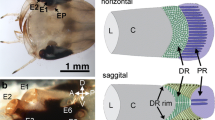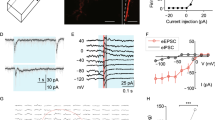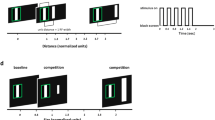Summary
Previous experiments have shown that during prey-catching behavior (orienting, snapping) in response to a worm-like moving stripe common toads.Bufo bufo (L.) exhibit a contrast-and direction-dependent edge preference. To a black (b) stripe moving against a white (w) background (b/w), they respond (R*) preferably toward the leading (l) rather the trailing (t) edge (R *l > R *t ), thus displaying ‘head preference’. If the contrastdirection is reversed (w/b), the stripe's trailing edge is preferred (R *l < R *t ), hence showing ‘tail preference’. In the present study, neuronal activities of retinal classes R2 and R3 and tectal classes T5(2) and T7 have been extracellularly recorded in response to leading and trailing edges of a 3 ° × 30 ° stripe simulating a worm and traversing the centers of their excitatory receptive fields (ERF) horizontally at a constant angular velocity in variable movement direction (temporo-nasal or naso-temporal).
The behavioral contrast-direction dependent edge preferences are best resembled by the responses (R) of prey-selective class T5(2) neurons (Rl∶ Rt=10∶1 for b/w, 0.3∶1 for w/b) and T7 neurons (Rl∶Rt=6∶1 for b/w, 0.4∶1 for w/b); the T7 responses may be dendritic spikes. This property can be traced back to off-responses dominated retinal class R3 neurons (Rl∶Rt=6∶1 for b/w, 0.5∶1 for w/b), but not to class R2 (Rl∶Rt =1.2∶1 for b/w and 0.9∶1 for w/b). The respective edge preference phenomena are independent of the direction of movement.
When stimuli were moved against a stationary black-white structured background, the ‘head preference’ to the black stripe and the ‘tail preference’ to the white stripe were maintained in class R3, T5(2), and T7 neurons. If the stripe traversed the ERF together with the structured background in the same direction at the same velocity, the responses of tectal class T5(2) and T7 neurons were strongly inhibited, particularly in the former. Responses of retinal R2 neurons in comparable situations could be reduced by about 50%, while class R3 neurons responded to both the stimulus and the moving background structure.
The results support the concept that the prey feature analyzing system in toads applies principles of (i) ‘parallel’ and (ii) ‘hierarchial’ information processing. These are (i) divergence of retinal R3 neuronal output contributes to stimulus edge positioning and (in combination with R2 output) area evaluation intectal neurons and to stimulus area evaluation and (in combination with R4 output) sensitivity for moving background structures inpre tectal neurons; (ii) convergence of tectal excitatory and pretectal inhibitory inputs specify the property of prey-selective tectal T5(2) neurons which are known to project to bulbar/spinal motor systems.
Similar content being viewed by others
Abbreviations
- ERF :
-
excitatory receptive field
- IRF :
-
inhibitory receptive field
- N :
-
nasal
- T :
-
temporal
- R w :
-
response to a worm-like stripe moving in the direction of its longer axis
- R A :
-
response to an antiworm-like stripe whose longer axis is oriented perpendicular to the direction of movement
- R l :
-
response to the leading edge of a worm-like moving stripe
- R t :
-
response to the trailing edge of a worm-like moving stripe
- b/w :
-
black stimulus against a white background
- w/b :
-
white stimulus against a black background
- sm :
-
structured moving background
- ss :
-
structured stationary background
- u :
-
minimal structure width of a structured background consisting of rectangular black and white patches in random distribution
- HRP :
-
horseradish peroxidase
References
Apfelbach R, Wester U (1977) The quantitative effect of visual and tactile stimuli on the prey-catching behaviour of ferrets (Putorius furo L). Behav Processes 2:187–200
Barlow HB (1953) Summation and inhibition in the frog's retina. J Physiol 119:69–88
Barlow HB (1985) The twelfth Barlett Memoiral Lecture: The role of single neurons in the psychology of perception. Q J Exp Biol 37(A):121–145
Burghagen H (1979) Der Einfluß von figuralen, visuellen Mustern auf das Beutefangverhalten verschiedener Anuren. Math-Nat dissertation, University of Kassel
Burghagen H, Ewert J-P (1982) Question of ‘head preference’ in response to worm-like dummies during prey-capture of toadsBufo bufo. Behav Processes 7:295–306
Burghagen H, Ewert J-P (1983) Influence of the background for discriminating object motion from self-induced motion in toads (Bufo bufo L). J Comp Physiol 152:241–249
Ewert J-P (1968) Der Einfluß von Zwischenhirndefekten auf die Visuomotorik im Beute- und Fluchtverhalten der Erdkröte (Bufo bufo L.). Z Vergl Physiol 61:41–70
Ewert J-P (1974) The neural basis of visually guided behavior. Sci Am 230:34–42
Ewert J-P (1984) Tectal mechanisms that underlie prey-catching and avoidance behaviors in toads. In: Vanegas H (ed) Comparative neurology of the optic tectum. Plenum Press, New York
Ewert J-P (1987) Neuroethology of releasing mechanisms: Prey-catching in toads. Behav Brain Sci (in press)
Ewert J-P, Gebauer L (1973) Größenkonstanzphänomene im Beutefangverhalten der Erdkröte (Bufo bufo L.). J Comp Physiol 85:303–315
Ewert J-P, Hock F (1972) Movement-sensitive neurones in the toad's retina. Exp Brain Res 16:41–59
Ewert J-P, Institut für den Wissenschaftlichen Film (1982) Gestalt perception in the common toad I: Innate prey recognition. Inst Wiss Film C1430, Göttingen
Ewert J-P, von Wietersheim A (1974a) Musterauswertung durch tectale and thalamus/praetectale Nervennetze im visuellen System der Kröte (Bufo bufo L.). J Comp Physiol 92:131–148
Ewert J-P, Wietersheim A von (1974b) Der Einfluß von Thalamus/Praetectum-Defekten auf die Antwort von Tectum-Neuronen gegenüber bewegten visuellen Mustern bei der Kröte (Bufo bufo L.). J Comp Physiol 92:149–160
Ewert J-P, Speckhardt I, Amelang W (1970) Visuelle Inhibition und Exzitation im Beutefangverhalten der Erdkröte (Bufo bufo L.). Z Vergl Physiol 68:84–110
Goethe F (1940) Beiträge zur Biologie des Iltis. Z Säugetierkunde 15:180–221
Grüsser O-J, Grüsser-Cornehls U (1968) Neurophysiologische Grundlagen visueller angeborener Auslösemechanismen beim Frosch. Z Vergl Physiol 59:1–24
Grüsser O-J, Grüsser-Cornehls U (1976) Neurophysiology of the anuran visual system. In: Llinás R, Precht W (eds) Frog Neurobiology. Springer, Berlin Heidelberg New York
Grüsser-Cornehls U (1984) The neurophysiology of the amphibian optic tectum. In: Vanegas H (ed) Comparative neurology of the optic tectum. Plenum Press, New York
Hartline HK (1940) The receptive fields of optic nerve fibers. Am J Physiol 130:690–699
Herbst G (1981) Quantitative Untersuchungen zur Frage der Invariantenbildung beim Beuteerkennen verschiedener Subspecies der Erdkröte (Bufo bufo bufo undBufo bufo spinosus). Staatsexamen Thesis, University of Kassel
Ingle D (1968) Visual releasers of prey catching behavior in frogs and toads. Brain Behav Evol 1:500–518
Ingle D (1983) Brain mechanisms of visual localization by frogs and toads. In: Ewert J-P, Capranica RR, Ingle DJ (eds) Advances in vertebrate neuroethology. Plenum Press, New York
Ingle D, McKinley D (1978) Effects of stimulus configuration on elicited prey catching by the marine toad (Bufo marinus). Anim Behav 26:885–891
Ingle DJ, Quinn S (1982) Retrograde labelling of neurons of known behavioral function in frog tectum. Soc Neurosci Abstr 8:406
Julesz B (1976) Experiments in the visual perception of texture. In: Held R, Richards W (eds) Recent progress in perception (Readings from Scientific American). Freeman, San Francisco
Lettvin JY, Maturana HR, McCulloch WS, Pitts WH (1959) What the frog's eye tells the frog's brain. Proc Inst Radio Eng NY 47:1940–1951
Leyhausen P (1965) Über die Funktion der relativen Stimmungshierarchie (dargestellt am Beispiel der phylogenetischen und ontogenetischen Entwicklung des Beutefangs von Raubtieren). Z Tierpsychol 22:412–494
Matsumoto N, Schwippert WW, Ewert J-P (1986) Intracellular activity of morphologically identified neurons of the grass frog's optic tectum in response to moving configurational visual stimuli. J Comp Physiol A 159:721–739
Maturana HR, Lettvin JY, McCulloch WS, Pitts WH (1960) Anatomy and physiology of vision in the frog (Rana pipiens). J Gen Physiol 43:129–176
Rasa OA (1973) Prey capture, feeding techniques, and their ontogeny in the African dwarf mongoose (Helogale undulata rufula. Z Tierpsychol 32:449–488
Satou M, Ewert J-P (1985) The antidromic activation of tectal neurons by electrical stimuli applied to the caudal medulla oblongata in the toadBufo bufo L. J Comp Physiol A 157:739–748
Székely G, Lázár G (1976) Cellular and synaptic architecture of the optic tectum. In: Llinás R, Precht W (eds) Frog neurobiology. Springer, Berlin Heidelberg New York, pp 407–434
Tsai HJ, Ewert J-P (1987) Influence of stationary and moving background structures on the response of visual neurons to moving configurational stimuli in toads. Brain Behav Evol (in press)
Tsai HJ, Burghagen H, Schürg-Pfeiffer E, Ewert J-P (1983) Neuronal correlates of edge-orientation in toadsBufo bufo. Naturwissenschaften 70:310–311
Author information
Authors and Affiliations
Rights and permissions
About this article
Cite this article
Tsai, H.J., Ewert, J.P. Edge preference of retinal and tectal neurons in common toads (Bufo bufo) in response to worm-like moving stripes: the question of behaviorally relevant ‘position indicators’. J. Comp. Physiol. 161, 295–304 (1987). https://doi.org/10.1007/BF00615249
Accepted:
Issue Date:
DOI: https://doi.org/10.1007/BF00615249




